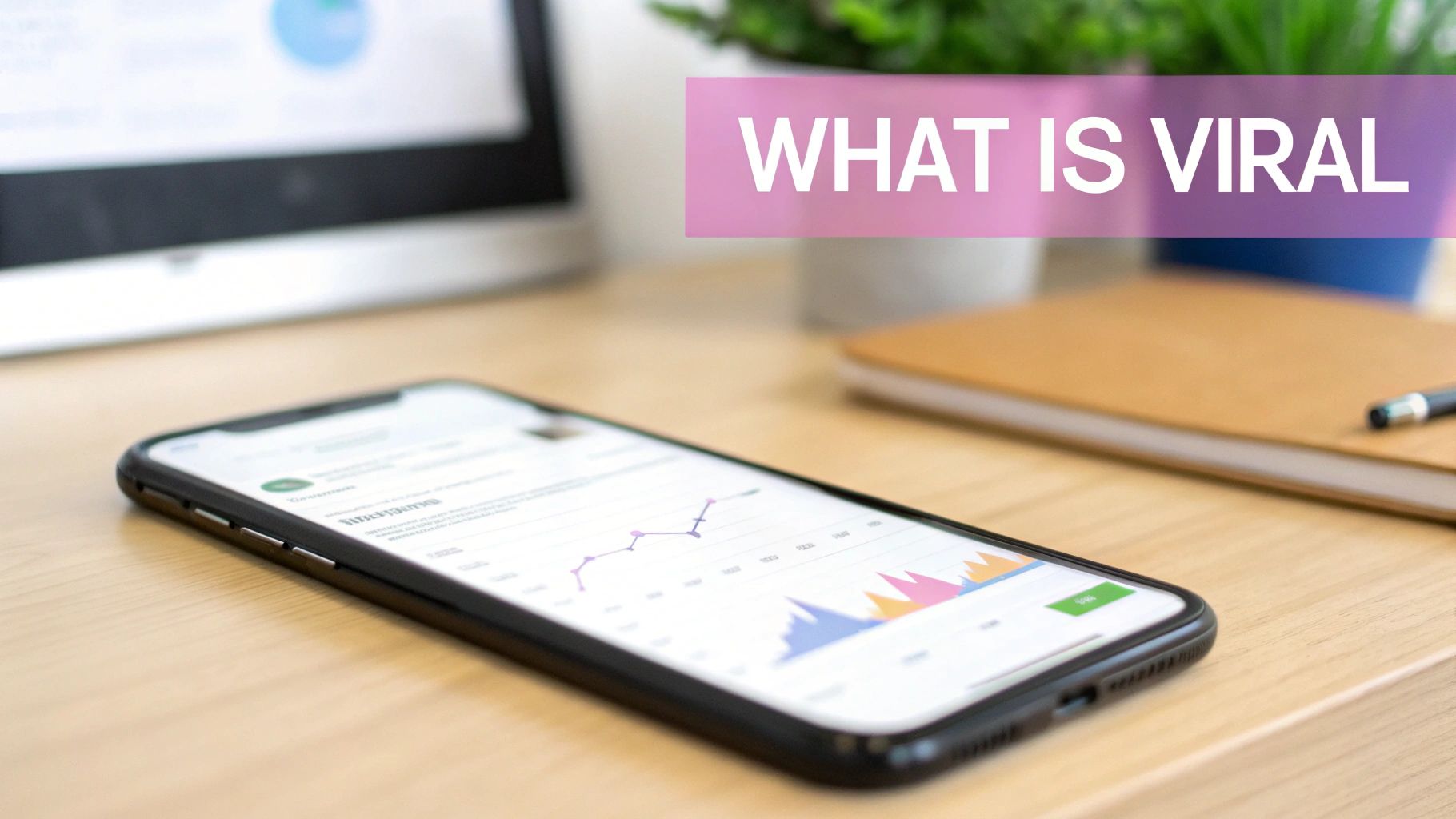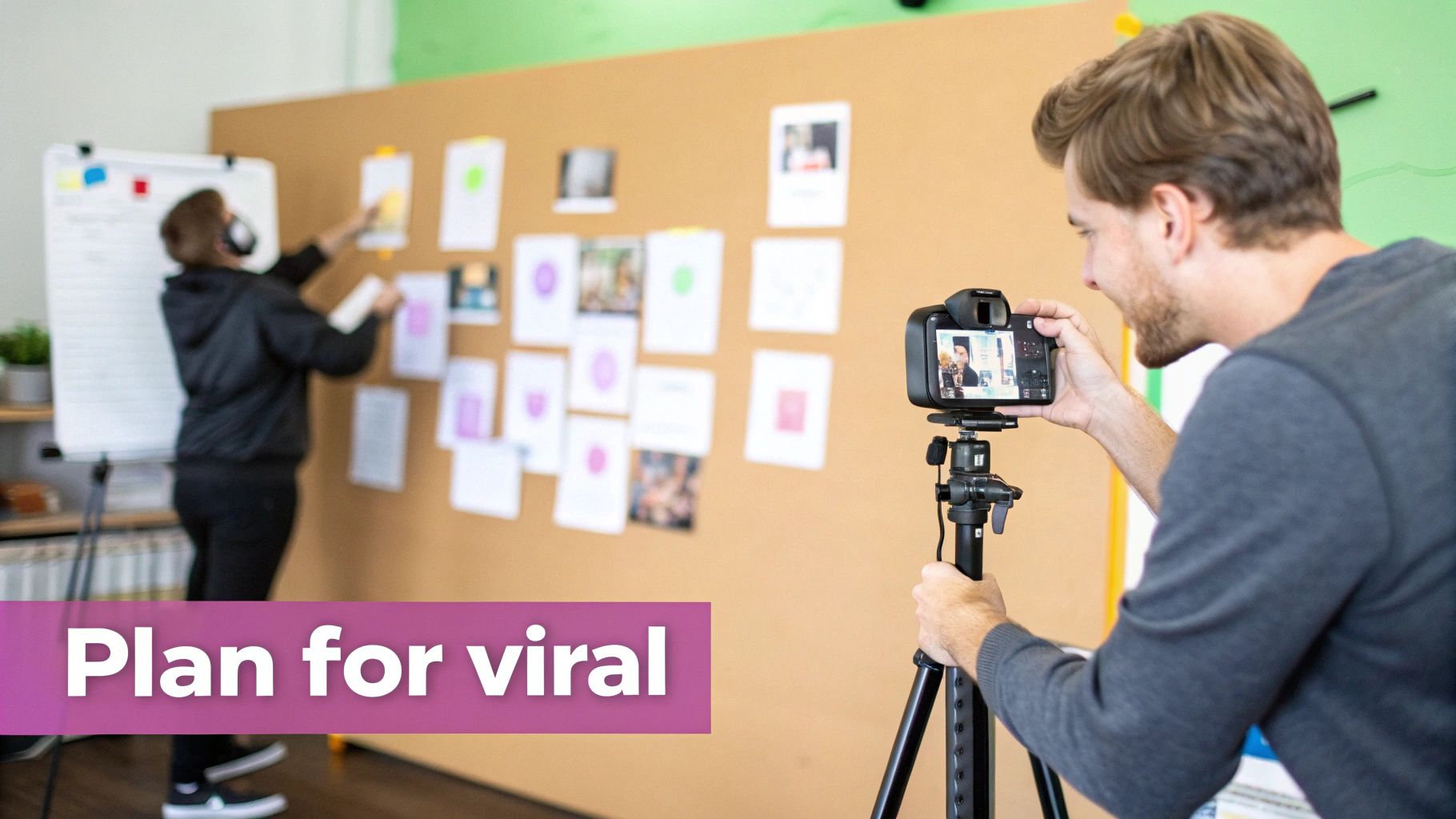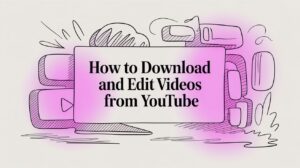So, you want to know the magic number for "going viral"? The truth is, it's not a single number—it’s more like a moving target. While hitting 1 million views is often seen as a solid benchmark, true virality is less about the final count and more about how fast you get there and where it happens.
So, What Does Going Viral Actually Mean?
Think of it like a real-world virus. Viral content spreads from person to person, organically and at an incredible speed. It's not just about getting a lot of eyeballs on your post; it's about achieving an explosion of shares, comments, and views in a really short amount of time.
Let's put it this way: a video that slowly climbs to 1 million views over six months is definitely a success, but it's not viral. On the other hand, a video that rockets to 1 million views in just 24-48 hours? That’s the lightning-in-a-bottle moment we’re talking about. This sudden surge is a massive signal to the platform's algorithm, which then pushes your content out to an even bigger audience.
It really boils down to three core ingredients that all work together.

As you can see, it’s the combination of the raw view count, the speed of those views, and the platform itself that truly defines virality.
The Real Ingredients of a Viral Hit
"Viral" is a relative term. For a smaller creator with only 1,000 followers, hitting 100,000 views is absolutely a viral moment for them. Why? Because their content has clearly broken far beyond their immediate follower circle and is being shared exponentially.
The secret to virality isn’t just the view count—it’s the velocity. Rapid engagement within the first few hours determines whether your content explodes or fizzles out.
To really get a handle on this, you need to look beyond the vanity metrics. The key factors are:
- View Velocity: This is all about how quickly the views pile up. A massive spike in views tells the algorithm that your content is hot right now and deserves to be shown to more people.
- Engagement Signals: Shares, comments, and saves are the fuel for the viral fire. In fact, some studies suggest that first-hour engagement determines up to 80% of your content’s potential to take off.
- Platform Context: A million views on TikTok, with its hyper-fast discovery engine, is a different beast than a million views on a long-form YouTube video, which often builds momentum more slowly.
Ultimately, going viral is about sparking a conversation that takes on a life of its own. If you focus on the factors that drive that initial burst of interest, you're on the right track. Building a strong foundation is everything, and a great place to start is learning more about how to increase social media engagement.
Decoding Virality Across Platforms
The answer to "how many views is viral?" isn't a simple number. It's a moving target that completely changes depending on where you post your content. A viral hit on TikTok looks wildly different from one on YouTube because each platform has its own algorithm, user habits, and content style. Getting a handle on these platform-specific benchmarks is the first real step to setting goals that actually make sense for your content strategy.

Think of it like different sports arenas. Smashing a home run is a huge deal in baseball, but that same swing means absolutely nothing on a basketball court. In the same way, the view counts that signal a viral moment are completely tailored to the platform they live on.
TikTok: The Land of Rapid Explosions
On TikTok, virality is all about one thing: speed. The platform’s "For You Page" is a ridiculously powerful discovery engine that can take a video from zero views to millions practically overnight.
For a video to be considered truly viral on TikTok, you’re generally looking at over 1 million views within a tight 24 to 72-hour window. Anything less might still be a great performance, but it hasn't caught that explosive, self-sustaining fire that defines a real viral hit on this platform. A great example is Nathan Apodaca's "Dreams" video, which captured a chill vibe skateboarding to Fleetwood Mac. It blew up almost instantly, gaining millions of views in days and rocketing the 1977 song back to the top of the charts. That's TikTok virality.
YouTube: Long-Form and Shorts
YouTube really plays on two different timelines. For your classic long-form videos, virality is often more of a slow burn. These videos ask for a bigger time commitment from the viewer, so the goalposts for success look different.
A long-form YouTube video is typically considered viral when it climbs to 2 to 3 million views within its first few days. But for YouTube Shorts, the pace is much quicker and feels a lot more like TikTok. A Short is usually labeled viral when it blows past 1 to 2 million views in a very short amount of time.
Instagram Reels: Visuals and Shareability
Instagram Reels sits somewhere in the middle, blending TikTok's velocity with YouTube's community feel. Here, virality is a powerful mix of high view counts and strong engagement signals—especially shares and saves.
A Reel often hits viral status when it racks up 3 to 4 million views within about a week. But here’s the interesting part: a video with a lower view count, maybe 500,000 views, could also be seen as viral if it has an insane number of shares—say, over 50,000. That tells you the content is so valuable or entertaining that users are doing the distribution work for you. Understanding the right format is key, and you can get a better sense of that by exploring how long Reels can be.
Key Takeaway: Platform dynamics dictate viral benchmarks. A million views in a day is a massive TikTok win, while a million views over a week on a long-form YouTube video is a solid, but not necessarily viral, success.
Keep in mind that all these goalposts are constantly shifting as more and more content floods the internet. A decade ago, a video hitting 1 million views was a monumental event. Today, the benchmarks are much higher across the board, simply because more people are online creating and consuming content. You can read more about these evolving video marketing statistics to see just how much the landscape has changed.
Measuring the Metrics That Matter Most
https://www.youtube.com/embed/Xqy9L-88wcw
It's so easy to get fixated on a huge, flashy view count, but that number really only tells you a piece of the story. Genuine virality is less about how many people saw your content and more about what they did after they saw it. The metrics that truly matter are the ones that show how fast your content is spreading and how deeply it's connecting with people.
Think about it this way: a video that gets a million views over the course of a year is definitely a success. But a video that pulls in a million views in its first 24 hours? That's a phenomenon. This is the power of velocity—the speed at which your content racks up views and engagement. A sudden, massive spike in activity is the clearest signal you can send to an algorithm that your content is hot and needs to be shown to more people, right now.
The Signals That Fuel Explosive Growth
Beyond the speed of views, a few key engagement metrics give you a much richer picture of your content’s viral potential. These actions prove that viewers aren't just passively watching; they're getting involved and actively helping your content catch fire.
These are the engagement signals you need to watch:
- Shares: This is the ultimate stamp of approval. When someone shares your video, they’re putting their own reputation on the line to vouch for it.
- Comments: Comments get a conversation going and build a sense of community. To the algorithm, this signals high relevance and keeps people on the platform longer.
- Saves: A save is a powerful signal that your content is so valuable, someone wants to come back to it later. On many platforms, a save carries more weight than a simple like.
- Watch Time: A high average watch time or completion rate tells the algorithm your content is captivating enough to hold people's attention—a crucial factor for getting it promoted.
You simply can't go viral without high engagement. In fact, many creators and marketers will tell you that the first-hour engagement determines up to 80% of your content’s chance to really take off.
Calculating a Simple Virality Score
To get beyond those tempting vanity metrics, you can use a simple framework to get a better sense of your content's real momentum. While there's no official industry standard, thinking in terms of a 'Virality Score' helps you focus on what actually matters.
Virality is a function of reach multiplied by engagement, divided by time. The faster you can get high engagement across a wide audience, the more likely your content will achieve liftoff.
A simplified way to put this into a formula would be:
(Views x Engagement Rate) / Time = Virality Score
For instance, a video that gets 500,000 views with a 10% engagement rate in just 24 hours has a way higher virality score than a video with 1,000,000 views and a 3% engagement rate over a full week. The first video is showing that explosive, immediate impact, and that's the real engine of viral growth. By focusing on velocity and deep engagement, you can better understand what "viral" actually means for you.
The Psychology Behind Viral Content
A massive view count is a symptom of virality, not the cause. The real engine behind content that spreads like wildfire is human psychology. If you can understand why people feel that almost irresistible urge to hit the "share" button, you've found the secret to creating truly shareable content.
It almost always boils down to one thing: emotion. Content that makes us feel something powerful—whether it's awe, surprise, laughter, or even anger—creates a response that needs an outlet. Sharing becomes that outlet, a simple way to connect with others over a common feeling.

This emotional spark is precisely why such a tiny fraction of content, roughly 0.3% of posts, ever breaks the 1 million view mark. The pieces that succeed almost always deliver a strong emotional punch or provide incredible practical value. A classic example is the "Ice Bucket Challenge." It combined novelty (dumping ice water on your head), social proof (seeing friends do it), and a powerful emotional cause (fighting ALS), creating a perfect storm for shares. You can dig into more of the numbers with some data-driven insights on what makes content go viral on sujanpatel.com.
Tapping into Key Emotional Triggers
Certain emotions are far more likely to spark a share than others. While a whole spectrum of feelings can get the job done, a few consistently rise to the top when it comes to creating those breakout viral moments.
By aiming for these core emotions, you can craft content that connects on a much deeper level:
- Awe and Wonder: Think of breathtaking nature videos or stories of incredible human achievement. Content that inspires or makes us see the world in a new way creates a powerful sense of awe that people feel compelled to share.
- Humor: Laughter is a universal language. Funny videos, relatable skits, and clever memes are arguably the most shared content types because they offer a quick hit of joy that people can't wait to pass on.
- Surprise and Novelty: Our brains are wired to pay attention to things that break the pattern. An unexpected plot twist, a shocking statistic, or a completely new idea makes content instantly memorable and shareable.
- Belonging: Content that reinforces a shared identity—like an inside joke for a specific community—makes people feel like part of a group. This taps into our basic human need for connection.
The Power of Social Currency
Beyond raw emotion, another huge psychological factor is the idea of social currency. People share things to influence how others see them. They want to look smart, funny, helpful, or just plain in-the-know.
When you create content that makes your audience look good by sharing it, you are giving them a tool to build their own social status. This turns your viewers into your most effective distribution team.
Think about it. Sharing a post with a brilliant life hack makes someone look resourceful and clever. Sharing a witty meme makes them seem funny and culturally relevant. When you create content that offers this kind of social currency, you give your audience a personal stake in spreading your message.
How to Engineer Content for Virality
Hoping your content goes viral is like buying a lottery ticket. Engineering it for virality? That's playing poker—it's a game of skill, strategy, and playing the odds in your favor. While there's no magic button, you can absolutely stack the deck to dramatically increase the chances of your content taking off. It all comes down to a smart approach to creation, distribution, and a workflow that doesn’t burn you out.
It all starts in the blink of an eye. Those first three seconds are everything. You have to give someone a reason to stop their mindless scrolling, and you have to do it instantly. Statistics show that you lose a significant portion of your audience after just a few seconds. A powerful hook is non-negotiable—think of it as a bold question, a surprising visual, or a statement that makes people lean in.
Perfecting Your Content and Distribution
Once you've hooked them, you need to deliver a story that connects. Relatability is the currency of social media. When people see a piece of themselves in your content—a shared frustration, a common goal, a funny moment—they don't just watch it. They feel it. And that feeling is what turns a viewer into a sharer.
To give your content that initial shove it needs to start rolling downhill, nail these fundamentals:
- Tap into Trending Audio: On TikTok and Reels, popular sounds are like a fast-pass for the algorithm. Using a trending track or audio clip is one of the easiest ways to get your video in front of people who would never have seen it otherwise.
- Post at Peak Times: Don't just throw your content out there whenever it's ready. Dig into your analytics and find out when your audience is actually online and scrolling. Posting during these peak windows gives your video the best possible launchpad for immediate engagement.
- Use the Right Hashtags: Hashtags aren't just for decoration; they're how the algorithm categorizes your content. A good mix of broad, high-traffic tags (like #viralvideo) and super-specific, community-focused ones will help you attract a big audience and the right audience. For a closer look at what works, check out these actionable strategies for making viral videos.
Gaining a Competitive Edge with Automation
Sure, you can pour your heart and soul into one video and hope it’s “the one.” But the real challenge is producing great content consistently enough to give yourself more shots on goal. This is where your workflow becomes your secret weapon. The most successful creators aren't necessarily working harder; they're working smarter by automating the grunt work.
Think about it: what if you could turn a single hour-long podcast into a dozen different, engaging short-form clips? That's not a fantasy—it's what an automated repurposing workflow does. By intelligently identifying the most compelling moments from your long-form content, Swiftia automates the tedious work of clipping, captioning, and preparing videos for every social platform. This means you can scale your output without scaling your team. We break this down even further in our guide to creating short-form videos for TikTok and Reels.
The Edge: An automated repurposing system lets you test more ideas, more frequently, without putting in more hours. You stop being a manual video editor and start being a creative strategist, massively increasing your at-bats for a viral home run.
This isn't just about saving time. It’s about building a reliable content engine. By systematically mining your long-form content for gold, you create a steady pipeline of clips. Each one is another chance to catch fire, another opportunity to feed the algorithm, and another step toward making widespread reach a predictable result instead of a random accident.
Understanding Virality on a Massive Scale
When you want to grasp what "viral" truly means, you have to look at the biggest stage of them all: YouTube. This is where view counts can hit astronomical figures, blurring the line between a popular video and a full-blown cultural moment.
On YouTube, we see the absolute peak of viral potential, illustrating the difference between a video that simply gets a lot of views and one that shapes conversations globally.

Unlike the flash-in-the-pan nature of TikTok, going viral on YouTube is often a longer game, especially for traditional, long-form videos. A piece of content might build steam slowly over weeks or months, gradually embedding itself into the culture and piling up millions of views along the way.
The Slow Burn Versus Fast Explosions
Think of it like this: a classic YouTube video is a slow-burning fire. It catches on, grows steadily, and spreads as the algorithm recognizes its long-term value. A YouTube Short, on the other hand, is a firework—it's built for an immediate, spectacular burst of attention, much like what you'd see on other short-form platforms.
On YouTube, virality isn't just about one video hitting the jackpot. It’s a reflection of the platform’s colossal scale. With so many users and so much content, even niche interests have the potential to reach an enormous audience.
For a real-world example of this scale, just look at "Baby Shark Dance." It’s the most-viewed YouTube video ever, sitting at nearly 16 billion views. That number isn’t just big; it's a testament to how a single video can achieve planetary reach.
Channels like Wiz Khalifa Music pull in over 5 billion monthly views, proving how consistent output can connect with this massive audience. And with 2 billion monthly active users on YouTube Shorts alone, the platform is now minting viral hits at a much faster pace. You can find more YouTube statistics and insights on awisee.com.
This dual ecosystem really shows how the platform itself defines what "viral" looks like. Whether it's the sustained climb of a deep-dive video or the rapid-fire spread of a 60-second clip, YouTube proves there are many paths to reaching a massive audience.
Your Top Questions About Going Viral, Answered
Even after laying out a game plan, a few questions always seem to come up when you're chasing that viral moment. Let's dig into some of the most common ones and get them cleared up once and for all.
Can You Just Pay to Make a Video Go Viral?
You can definitely pay for views, but that’s not the same thing as going viral. Running ads can give your content an initial push and get it in front of more eyeballs, but real virality is an organic phenomenon.
It happens when people share your content because they genuinely love it, not because you paid to put it in their feed. A paid boost might get the ball rolling, but it can’t fake the authentic excitement that makes something a true viral hit.
How Long Does It Take for Content to Go Viral?
This is the million-dollar question, and the answer is… it depends! There's no magic timeline. Some videos explode within a few hours, racking up millions of views by the time you wake up the next morning. This kind of lightning-fast spread is pretty common on platforms like TikTok, where the algorithm can catapult a video into the stratosphere almost instantly.
But then there's the "slow burn." This happens a lot on YouTube, where a video might chug along for days or even weeks before it finally finds its audience and starts to pick up serious steam.
Is Going Viral Always a Good Thing?
Absolutely not. Going viral can be a double-edged sword. If your content blows up for the wrong reasons—think a public blunder, a controversial take, or a brand message gone horribly wrong—the wave of negative attention can do some serious damage to your reputation.
The goal is to go viral for the right reasons, with content that aligns with your brand and attracts the kind of audience you actually want to keep. Many creators get hung up on specific numbers, but it's more nuanced than that. If you want a deeper dive into platform-specific benchmarks, you can learn more about how many views is considered viral on TikTok to see how the numbers break down.
Ready to create more viral moments without spending more time editing? Swiftia transforms your long-form videos into dozens of shareable, high-impact clips 10x faster. Automate your repurposing workflow and give every piece of content its best shot at going viral. Explore how it works at https://swiftia.io.


